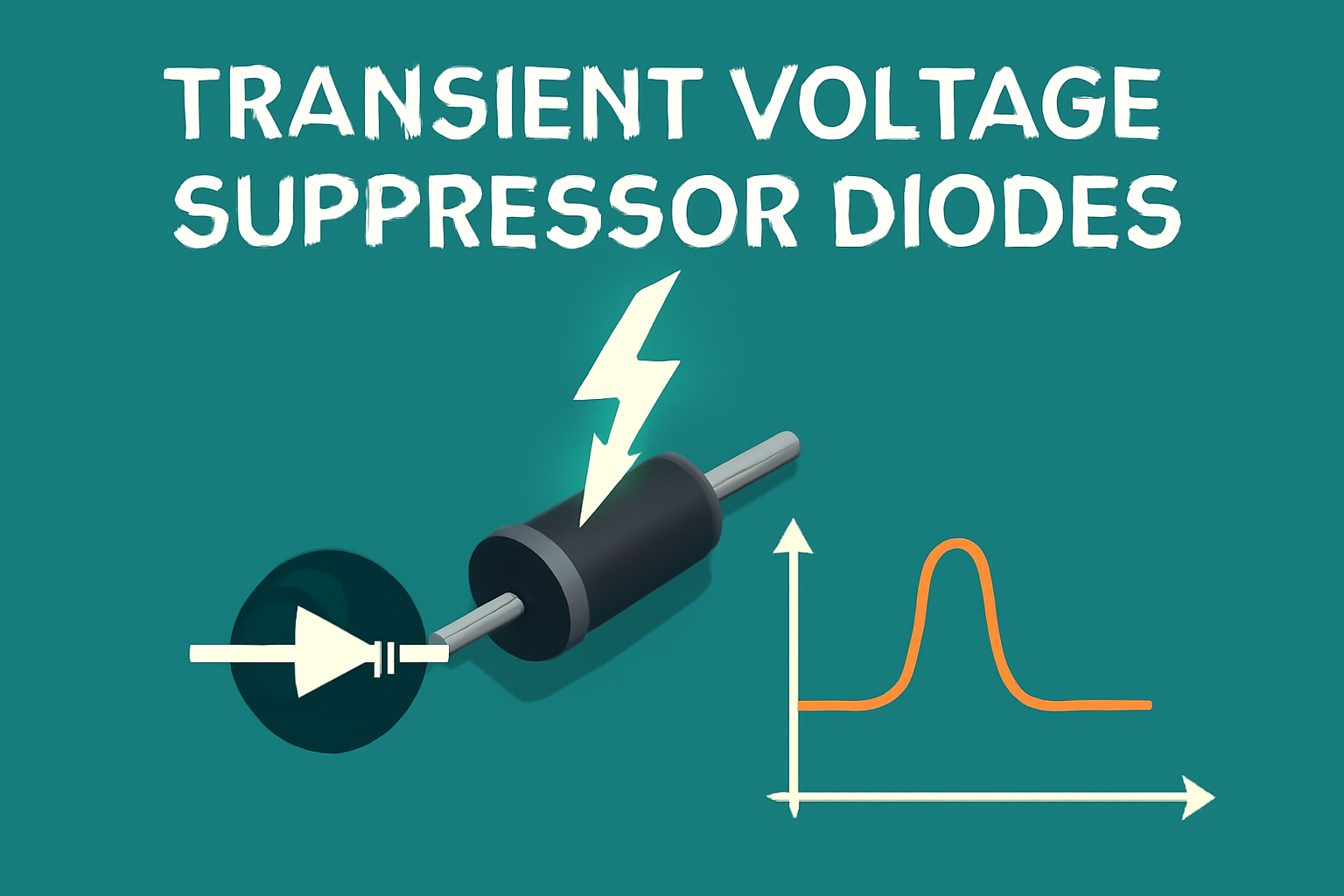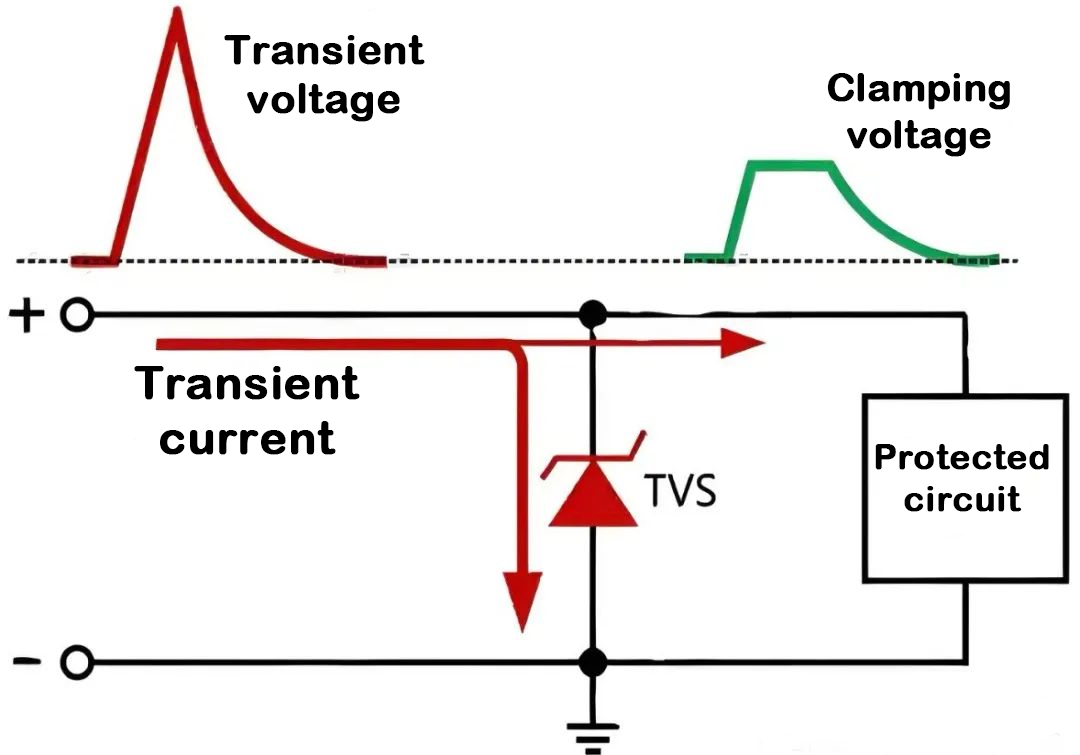The TVS (Transient Voltage Suppression) diode is a high-speed circuit protection component designed to protect electronic components from overvoltage, electrostatic discharge, and surge currents. It is widely used in USB, HDMI, and industrial power systems to provide effective voltage clamping protection.

A TVS (Transient Voltage Suppressor) diode is a high-speed overvoltage protection component. It protects sensitive electronic circuits from transient voltage spikes caused by electrostatic discharge (ESD), lightning surges, and power switching transients. TVS diodes are based on avalanche breakdown mechanisms and typically react in less than 1 nanosecond to clamp excess voltage to a safe level.

|
English Term |
Definition |
Engineering Notes |
|
Reverse Stand-off Voltage (VR) |
Maximum voltage the TVS diode can withstand in a non-conductive state. |
Should be 10–15% higher than system voltage to prevent false triggering. |
|
Breakdown Voltage (VBR) |
Voltage at which the diode begins to conduct under test current (e.g., 1mA). |
Should exceed VR but remain below the max voltage tolerance of the protected device. |
|
Clamping Voltage (VC) |
Maximum voltage across the diode at peak pulse current. |
Must be below the withstand voltage of the protected components. |
|
Peak Pulse Current (IPP) |
Maximum surge current the diode can handle during a transient event. |
Choose based on surge expectations with 1.5–2x safety margin. |
|
Peak Pulse Power (PPP) |
Maximum energy the diode can absorb in a specified pulse (e.g., 10/1000μs). |
Higher power is preferred in industrial or strong surge environments. |
|
Reverse Leakage Current (IR) |
Small leakage current at VR voltage. |
Lower IR is better for low-power or precision systems. |
|
Junction Capacitance (Cj) |
Capacitance due to the diode’s internal PN junction. |
Low capacitance (<5pF) is essential for high-speed signal lines like USB, HDMI. |
|
Response Time |
Time from overvoltage detection to conduction; typically <1ns. |
Key advantage of TVS vs. MOV/GDT in ESD/high-speed environments. |
|
Package Type |
Physical formats such as SMA, SMB, SMC. |
Affects dissipation and surge rating; e.g., SMB for 600–1500W, SOD323 for micro circuits. |
|
Package |
Peak Power (P_PP) |
Typical Applications |
System Voltage |
VR |
VBR |
VC |
Example Models |
|
SMA |
400W |
USB/HDMI/RS232 ports, MCU I/O, small appliances |
5V/ |
5.5V/ |
6.2–7.5V/ |
10–18V |
SMBJ6.5CA,SMAJ12CA |
|
SMB |
600W |
Power input, LED drivers, instrumentation |
12V/ |
13–26V |
16–28V |
24–40V |
SMBJ24A,SMBJ33A |
|
SMC |
1500W |
Industrial control, telecom base stations, AC mains |
24V–48V/ |
26–56V |
30–60V |
38–80V |
SMCJ36A,SMCJ58A,SMCJ70A |
Parameter Matching Guidelines
• VR (Reverse Stand-off Voltage): Should be slightly higher than the actual system voltage (typically ×1.1~1.2).
• VBR (Breakdown Voltage): Should remain between system tolerance and the clamping threshold.
• VC (Clamping Voltage): Must be lower than the maximum allowable voltage of the protected components.
|
Application |
Recommended Package |
Model |
Typical Parameters |
Features |
|
USB 5V interface |
SMA |
SMAJ6.0CA |
VR = 5.5V VBR = 6.4V VC ≈ 10V |
Fast response, low capacitance for data lines |
|
24V power input |
SMB |
SMBJ24A |
VR = 24V VBR = 26.7V VC ≈ 38.9V |
Mid-range clamping, suitable for DC input surge |
|
Industrial AC 220V |
SMC |
SMCJ70A |
VR = 70V VBR ≈ 78V VC ≈ 113V |
High energy capacity, ideal for AC mains and relay protection |
1. Overvoltage Protection: Rapidly clamps voltage spikes (e.g., lightning, switching transients) to protect downstream devices.
2. ESD Protection: Ultra-fast reaction to electrostatic discharges on sensitive ports like USB, HDMI, LAN, RS-485.
3. Surge Immunity: Absorbs high transient currents from power surges in automation, power grids, or security systems.
4. Signal Line Integrity: Maintains data integrity in high-speed lines while providing effective voltage protection.
TVS diodes are cost-effective, fast-response components vital for circuit protection. With proper parameter selection and application-specific configuration, they greatly enhance system reliability under transient and electromagnetic interference conditions.